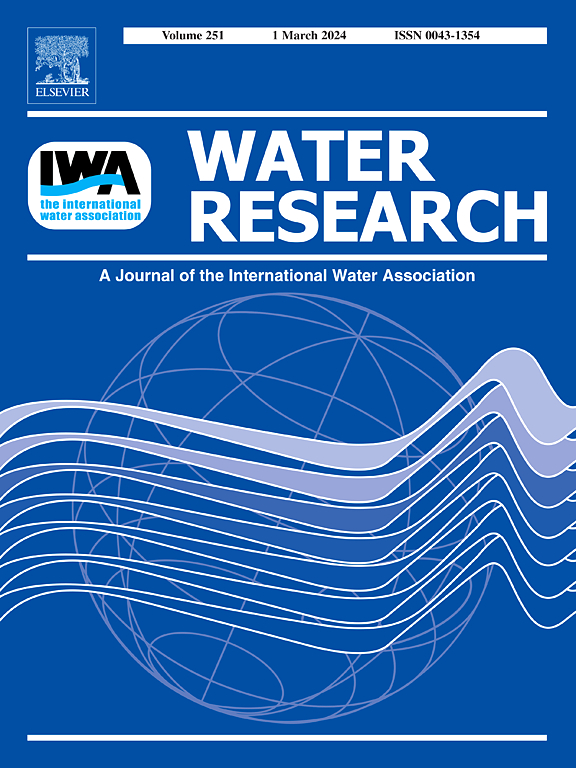Scalable, flexible and hydrophilic porous membrane with single-layered rGO-W18O49 nanoplates dispersion for high-efficiency solar water evaporation
IF 12.4
1区 环境科学与生态学
Q1 ENGINEERING, ENVIRONMENTAL
引用次数: 0
Abstract
Solar-driven interfacial evaporation has emerged as a prominent sustainable desalination technology due to its clear energy utilization and low operational costs. However, developing evaporators with high efficiency, structural stability, and salt-resistant properties remains a critical challenge. Herein, we designed an rGCWx@PVDF-PVP membrane fabricated via a facile phase inversion strategy, demonstrating exceptional solar evaporation performance and cyclic stability. The synergistic integration of rGO-xW18O49 nanoplates (W18O49 nanowires anchored on rGO surface) and CNTs enables broadband spectral absorbance (∼90.00%). The hierarchically porous PVDF-PVP membrane facilitates rapid water transport and provides substantial vapor escape channels. Notably, the incorporation of PVP with nitrogen-containing functional groups modulates water molecule interactions by weakening hydrogen bonding networks, and PVP effectively reduces the evaporation enthalpy of the water system and improves evaporation performance. Under 1 sun irradiation, the evaporator achieves an outstanding evaporation rate of 2.09 kg m−2 h−1 with a photothermal conversion efficiency of 92.80%. Remarkably, the evaporator maintains terrific performance in desalination without surface salt crystallization, demonstrating exceptional anti-fouling capability during prolonged operation. This novel and simple thin-film evaporator presents a broad prospect in the field of interfacial evaporation, offering a practical strategy for sustainable water purification and global freshwater scarcity.


具有单层rGO-W18O49纳米板的可伸缩、柔性和亲水多孔膜用于高效太阳能水蒸发
太阳能驱动的界面蒸发由于其清洁的能源利用和低运行成本而成为一种突出的可持续海水淡化技术。然而,开发具有高效、结构稳定和耐盐性能的蒸发器仍然是一个关键的挑战。在此,我们设计了一种rGCWx@PVDF-PVP膜,通过简单的相转化策略制造,具有出色的太阳能蒸发性能和循环稳定性。rGO- xw18o49纳米板(固定在rGO表面的W18O49纳米线)和碳纳米管的协同集成可实现宽带光谱吸收(~ 90.00%)。分层多孔PVDF-PVP膜促进快速水输送,并提供大量的蒸汽逃逸通道。值得注意的是,PVP与含氮官能团的掺入通过削弱氢键网络来调节水分子间的相互作用,PVP有效降低了水系统的蒸发焓,提高了蒸发性能。在1次太阳照射下,蒸发器的蒸发速率为2.09 kg m−2 h−1,光热转换效率为92.80%。值得注意的是,蒸发器在海水淡化中保持了出色的性能,没有表面盐结晶,在长时间运行中表现出卓越的防污能力。这种新颖简单的薄膜蒸发器在界面蒸发领域具有广阔的前景,为可持续水净化和全球淡水短缺提供了一种实用的策略。
本文章由计算机程序翻译,如有差异,请以英文原文为准。
求助全文
约1分钟内获得全文
求助全文
来源期刊

Water Research
环境科学-工程:环境
CiteScore
20.80
自引率
9.40%
发文量
1307
审稿时长
38 days
期刊介绍:
Water Research, along with its open access companion journal Water Research X, serves as a platform for publishing original research papers covering various aspects of the science and technology related to the anthropogenic water cycle, water quality, and its management worldwide. The audience targeted by the journal comprises biologists, chemical engineers, chemists, civil engineers, environmental engineers, limnologists, and microbiologists. The scope of the journal include:
•Treatment processes for water and wastewaters (municipal, agricultural, industrial, and on-site treatment), including resource recovery and residuals management;
•Urban hydrology including sewer systems, stormwater management, and green infrastructure;
•Drinking water treatment and distribution;
•Potable and non-potable water reuse;
•Sanitation, public health, and risk assessment;
•Anaerobic digestion, solid and hazardous waste management, including source characterization and the effects and control of leachates and gaseous emissions;
•Contaminants (chemical, microbial, anthropogenic particles such as nanoparticles or microplastics) and related water quality sensing, monitoring, fate, and assessment;
•Anthropogenic impacts on inland, tidal, coastal and urban waters, focusing on surface and ground waters, and point and non-point sources of pollution;
•Environmental restoration, linked to surface water, groundwater and groundwater remediation;
•Analysis of the interfaces between sediments and water, and between water and atmosphere, focusing specifically on anthropogenic impacts;
•Mathematical modelling, systems analysis, machine learning, and beneficial use of big data related to the anthropogenic water cycle;
•Socio-economic, policy, and regulations studies.
 求助内容:
求助内容: 应助结果提醒方式:
应助结果提醒方式:


